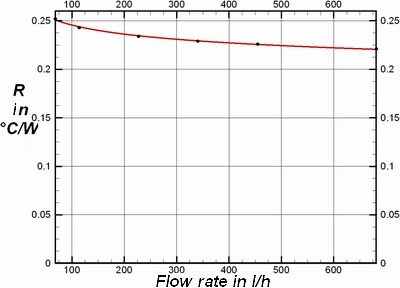www.leguman.ht.st
| head losses |
pumps |
convection |
| Conduction + Convection |
| Wb effect on the fluid flow |
| Radiation |
©
2001 - 2002.
|
| previous | ||
|
Do not capitulate ! all is recapitulated : To finish with heat transfer, let's establish the link between
convection and conduction seen in the first part of these articles.
Remember, the thermal power leaves the surface of the CPU, goes
to the base of the cooler through the interface between these two
surfaces with the corresponding contact resistance Rc
, to arrive at the upper surface of the base with also corresponding
resistances, pure conduction R'c
and spreading Rs.
Then the thermal power is absorbed by the fluid, with thermal resistance Rcv . It is still added to Rcd to finally give the total resistance R between the CPU and the fluid. This total resistance is defined by :
Where Tcpu is the CPU's temperature, Tf that of the fluid (pratically the temperature at the entry of the cooler) and P the thermal power given by the CPU to the cooler. The temperature of this latter can also be written :
I point out the importance of thermal resistance, it
is the only parameter which allows to measure the thermal
performance of a cooling system and this independently
of the thermal power (thus independently of the CPU provided it
has the same surface area) and of the temperature of the fluid at
the entry (thus independently of what is between the input and the
output of the cooler considered). This chart shows what kind of curve can be obtained for thermal resistance R with an Innovacool Rev. 3 waterblock ( thanks to Bill Adams ) :
Knowing the thermal resistance of a cooling system is quite pretty, but that's not enough to know what its really worth ... |
||
| previous |

